The flat figure area represents the extent of the figure's extension in the plane. As flat figures, we can mention the triangle, the rectangle, the rhombus, the trapezoid, the circle, among others.
Use the questions below to check your knowledge of this important subject of geometry.
Contest Issues Resolved
question 1
(Cefet/MG - 2016) The square area of a site must be divided into four equal parts, also square, and, in one of them, a native forest reserve (hatched area) must be maintained, as shown in figure a follow.

Knowing that B is the midpoint of segment AE and C is the midpoint of segment EF, the hatched area, in m2, give me
a) 625.0.
b) 925.5.
c) 1562.5.
d) 2500.0.
Correct alternative: c) 1562.5.
Observing the figure, we notice that the hatched area corresponds to the area of the square with a side 50 m minus the area of the triangles BEC and CFD.
The measurement of side BE, of triangle BEC, is equal to 25 m, as point B divides the side into two congruent segments (midpoint of the segment).
The same happens with sides EC and CF, that is, their measurements are also equal to 25 m, as point C is the midpoint of segment EF.
Thus, we can calculate the area of triangles BEC and CFD. Considering a two sides known as the base, the other side will equal the height, since triangles are rectangles.
Calculating the area of the square and triangles BEC and CFD, we have:
Therefore, the hatched area, in m2, measures 1562.5.
question 2
(Cefet/RJ - 2017) A square with an x side and an equilateral triangle with a y side have areas of the same measure. Thus, it can be said that the x/y ratio is equal to:
Correct alternative: .
The information given in the problem is that the areas are the same, that is:
The area of the triangle is found by multiplying the base measurement by the height measurement and dividing the result by 2. Since the triangle is equilateral and the side equal to y, its height value is given by:
Therefore, it can be said that the x/y ratio is equal to .
question 3
(IFSP - 2016) A public square in the shape of a circle has a radius of 18 meters. In light of the above, mark the alternative that presents your area.
a) 1,017.36 m2
b) 1,254.98 m2
c) 1,589.77 m2
d) 1,698.44 m2
e) 1,710.34 m2
Correct alternative: a) 1 017, 36 m2.
To find the area of the square, we must use the formula for the area of the circle:
A = π.R2
Substituting the radius value and considering π = 3.14, we find:
A = 3.14. 182 = 3,14. 324 = 1 017, 36 m2
Therefore, the square area is 1 017, 36 m2.
question 4
(IFRS - 2016) A rectangle has dimensions x and y, which are expressed by the x equations2 = 12 and (y - 1)2 = 3.
The perimeter and area of this rectangle are respectively
a) 6√3 + 2 and 2 + 6√3
b) 6√3 and 1 + 2√3
c) 6√3 + 2 and 12
d) 6 and 2√3
e) 6√3 + 2 and 2√3 + 6
Correct alternative: e) 6√3 + 2 and 2√3 + 6.
First let's solve the equations, to find the values of x and y:
x2= 12 ⇒ x = √12 = √4.3 = 2√3
(y - 1) 2= 3 ⇒ y = √3 + 1
The perimeter of the rectangle will be equal to the sum of all sides:
P = 2.2√3 + 2. (√3 + 1) = 4√3 + 2√3 + 2 = 6√3 + 2
To find the area, just multiply x.y:
A = 2√3. (√3 + 1) = 2√3 + 6
Therefore, the perimeter and area of the rectangle are, respectively, 6√3 + 2 and 2√3 + 6.
question 5
(Apprentice Sailor - 2016) Analyze the following figure:
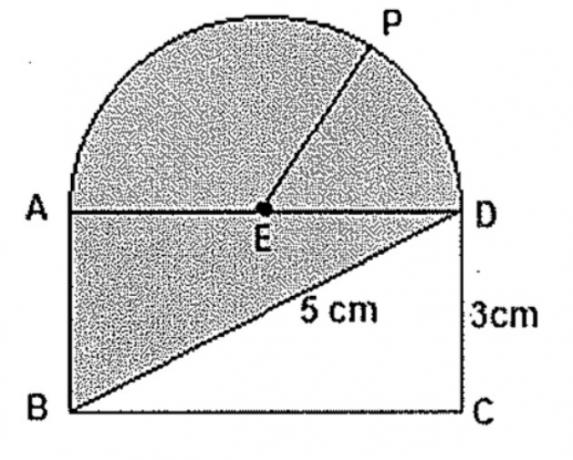
Knowing that EP is the radius of the center semicircle in E, as shown in the figure above, determine the value of the darkest area and check the correct option. Data: number π=3
a) 10 cm2
b) 12 cm2
c) 18 cm2
d) 10 cm2
e) 24 cm2
Correct alternative: b) 12 cm2.
The darkest area is found by adding the area of the semicircumference to the area of the triangle ABD. Let's start by calculating the area of the triangle, for that, note that the triangle is a rectangle.
Let's call the AD side of x and calculate its measure using the Pythagorean theorem, as indicated below:
52= x2 + 32
x2 = 25 - 9
x = √16
x = 4
Knowing the AD side measure, we can calculate the area of the triangle:
We still need to calculate the area of the semicircumference. Note that its radius will be equal to half the measure on the AD side, so r = 2 cm. The semicircumference area will be equal to:
The darkest area will be found by doing: AT = 6 + 6 = 12 cm2
Therefore, the value of the darkest area is 12 cm2.
question 6
(Enem - 2016) A man, father of two children, wants to buy two plots of land, with areas of the same measure, one for each child. One of the land visited is already demarcated and, although it does not have a conventional format (as shown in Figure B), it pleased the eldest son and, therefore, was purchased. The youngest son has an architectural project for a house he wants to build, but for that he needs of a terrain in rectangular form (as shown in Figure A) whose length is 7 m longer than the width.

To satisfy the youngest son, this gentleman needs to find a rectangular piece of land whose measurements, in meters, in length and in width are equal, respectively, to
a) 7.5 and 14.5
b) 9.0 and 16.0
c) 9.3 and 16.3
d) 10.0 and 17.0
e) 13.5 and 20.5
Correct alternative: b) 9.0 and 16.0.
Since the area of figure A is equal to the area of figure B, let's first calculate this area. For this, let's divide Figure B, as shown in the image below:
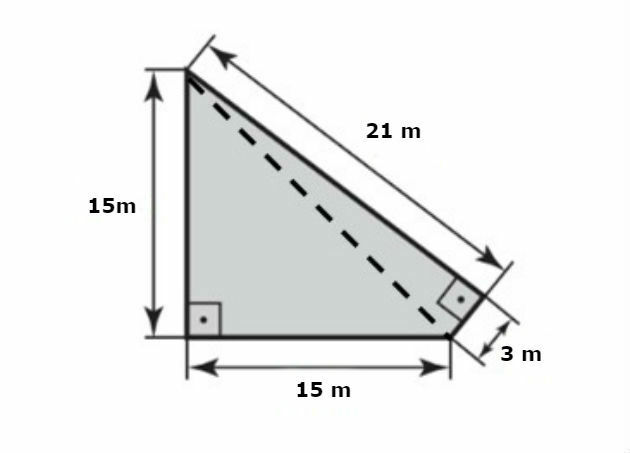
Note that when splitting the figure, we have two right triangles. Therefore, the area of figure B will be equal to the sum of the areas of these triangles. Calculating these areas, we have:
Since figure A is a rectangle, its area is found by doing:
THETHE = x. (x + 7) = x2 + 7x
Equating the area of figure A with the value found for the area of figure B, we find:
x2 + 7x = 144
x2 + 7x - 144 = 0
Let's solve the 2nd degree equation using Bhaskara's formula:
As a measure cannot be negative, let's just consider the value equal to 9. Therefore, the width of the land in figure A will be equal to 9 m and the length will be equal to 16 m (9+7).
Therefore, the length and width measurements must be equal to 9.0 and 16.0 respectively.
question 7
(Enem - 2015) A cell phone company has two antennas that will be replaced by a new, more powerful one. The coverage areas of the antennas that will be replaced are circles with a radius of 2 km, whose circumferences are tangent to point O, as shown in the figure.
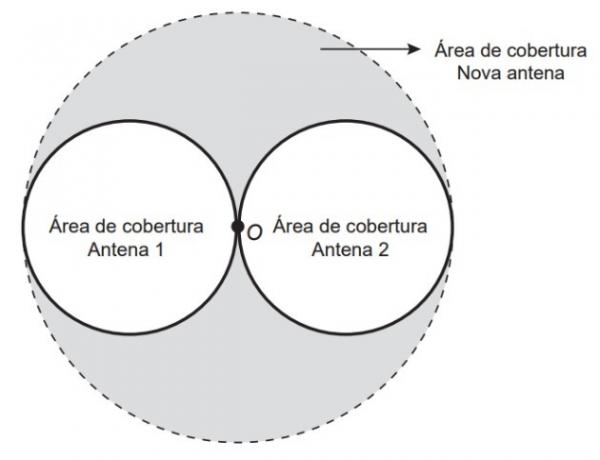
Point O indicates the position of the new antenna, and its coverage region will be a circle whose circumference will externally tangent the circumferences of the smaller coverage areas. With the installation of the new antenna, the measurement of the coverage area, in square kilometers, was expanded by
a) 8 π
b) 12 π
c) 16 π
d) 32 π
e) 64 π
Correct alternative: a) 8 π.
The magnification of the coverage area measurement will be found by decreasing the areas of the smaller circles of the larger circle (referring to the new antenna).
As the circumference of the new coverage region externally touches the smaller circumferences, its radius will be equal to 4 km, as indicated in the figure below:

Let's calculate the areas A1 and the2 of the smaller circles and area A3 from the larger circle:
THE1 = A2 = 22. π = 4 π
THE3 = 42.π = 16 π
The measurement of the enlarged area will be found by doing:
A = 16 π - 4 π - 4 π = 8 π
Therefore, with the installation of the new antenna, the coverage area measure, in square kilometers, was increased by 8 π.
question 8
(Enem - 2015) Diagram I shows the configuration of a basketball court. The gray trapezoids, called carboys, correspond to restricted areas.

Aiming to meet the guidelines of the Central Committee of the International Basketball Federation (Fiba) in 2010, which unified the markings of the different alloys, a modification was foreseen in the carboys of the courts, which would become rectangles, as shown in the Scheme II.

After carrying out the planned changes, there was a change in the area occupied by each carboy, which corresponds to a (a)
a) increase of 5800 cm2.
b) 75 400 cm increase2.
c) increase of 214 600 cm2.
d) decrease of 63 800 cm2.
e) decrease of 272 600 cm2.
Correct alternative: a) increase of 5800 cm².
To find out what the change in the occupied area was, let's calculate the area before and after the change.
In the calculation of scheme I, we will use the formula for the trapezium area. In diagram II, we will use the formula for the area of the rectangle.
The area change will then be:
A = AII - AI
A = 284 200 - 278 400 = 5 800 cm2
Therefore, after carrying out the planned modifications, there was a change in the area occupied by each carboy, which corresponds to an increase of 5800 cm².
Proposed exercises (with resolution)
question 9
Ana decided to build a rectangular pool in her house measuring 8 m base by 5 m high. All around it, shaped like a trapeze, it was filled with grass.

Knowing that the height of the trapeze is 11 m and its bases are 20 m and 14 m, what is the area of the part that was filled with grass?
a) 294 m2
b) 153 m2
c) 147 m2
d) 216 m2
Correct alternative: c) 147 m2.
As the rectangle, which represents the pool, is inserted inside a larger figure, the trapeze, let's start by calculating the area of the external figure.
The trapeze area is calculated using the formula:
Where,
B is the measure of the largest base;
b is the measure of the smallest base;
h is the height.
Substituting the statement data in the formula, we have:
Now, let's calculate the rectangle's area. For that, we just need to multiply the base by the height.
To find the area covered by grass, we need to subtract the space occupied by the pool from the trapeze area.
Therefore, the area filled with grass was 147 m2.
See too: Trapeze Area
question 10
To renovate the roof of his warehouse, Carlos decided to buy colonial tiles. Using this type of roof, 20 pieces are needed for each square meter of roof.
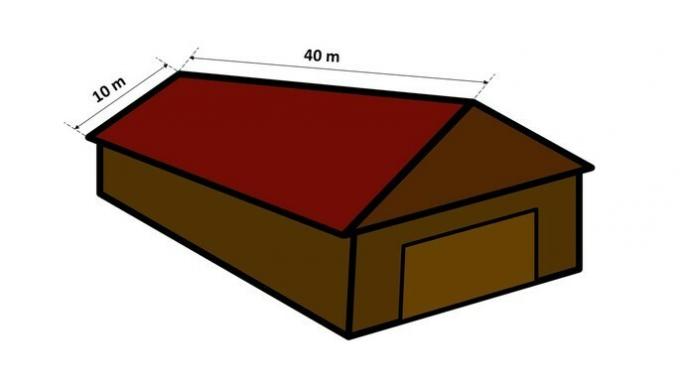
If the roof of the place is formed by two rectangular plates, as in the figure above, how many tiles does Carlos need to buy?
a) 12000 tiles
b) 16000 tiles
c) 18000 tiles
d) 9600 tiles
Correct alternative: b) 16000 tiles.
The warehouse roof is made of two rectangular plates. Therefore, we must calculate the area of a rectangle and multiply by 2.
Therefore, the total roof area is 800 m.2. If each square meter requires 20 tiles, using a simple rule of three we calculate how many tiles fill the roof of every warehouse.
Therefore, it will be necessary to buy 16 thousand tiles.
See too: Rectangle Area
question 11
Marcia would like two identical wooden vases to decorate the entrance to her house. Because she could only buy one of her favorites, she decided to hire a cabinetmaker to build another vase with the same dimensions. The vase must have four sides in an isosceles trapezoid shape and the base is a square.
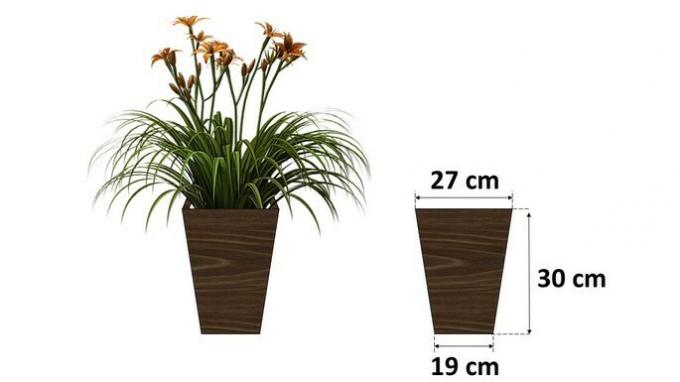
Without taking into account the thickness of the wood, how many square meters of wood will be needed to reproduce the piece?
a) 0.2131 m2
b) 0.1311 m2
c) 0.2113 m2
d) 0.3121 m2
Correct alternative: d) 0.3121 m2.
An isosceles trapeze is the type that has equal sides and different sized bases. From the image, we have the following measurements of the trapezius on each side of the vessel:
Smaller base (b): 19 cm;
Larger base (B): 27 cm;
Height (h): 30 cm.
With the values in hand, we calculate the trapezium area:
As the vessel is formed by four trapezoids, we need to multiply the area found by four.
Now we need to calculate the base of the vase, which is formed by a 19 cm square.
Adding the calculated areas, we arrive at the total area of wood to be used to build.
However, the area needs to be presented in square meters.
Therefore, without taking into account the thickness of the wood, 0.3121 m was needed2 of material to manufacture the vase.
See too: Square Area
question 12
To facilitate the calculation of how many people participate in public events, it is generally considered that one square meter is occupied by four people.

To celebrate the anniversary of a city, the city government hired a band to play in the square located in the center, which has an area of 4000 m2. Knowing that the square was packed, approximately how many people attended the event?
a) 16 thousand people.
b) 32 thousand people.
c) 12 thousand people.
d) 40 thousand people.
Correct alternative: a) 16 thousand people.
A square has four equal sides and has its area calculated by the formula: A = L x L.
if in 1 m2 it is occupied by four people, so 4 times the square's total area gives us the estimate of people who attended the event.
Thus, 16 thousand people participated in the event promoted by the city hall.
To learn more, see also:
- Flat Figure Areas
- Geometric Shapes
- Pythagoras Theorem - Exercises

